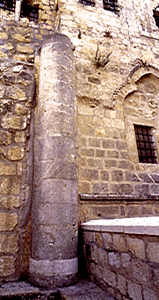
The plan at left, shows the excavated archaeological remains of the Crusader church and the rest of the structure that is presumed but not found. In the northwest corner of the building, bottom left, eight pillar and half-pillar foundations and one pillar pedestal were found in excavations. A portion of the western exterior wall including its southern corner, lower right, was discovered during the author's recent investigations. A part of the foundation of this wall appears in this photo; it incorporates a Byzantine or Roman column, the flat, round stone near the center in the third course from the top. The southwestern corner is in exact alignment with the ancient Judeo-Christian synagogue's southern wall, which is extant to a height of about 12 feet. From this alignment the full length of the southern wall of the Crusader church is projected on the plan. In the southeastern part of the basilica, upper right, then cenacle building from Crusader times still stands, as do some of the walls from the first-century Apostolic Church, which now enclose the pseudo-tomb of David. Among the Crusader remains is the upper half of a column (shown at left and on the plan at left) that once extended from the ground floor up to the ceiling of the church; today it stands just outside the cenacle building, next to the entrance to the upper room.
Above the remaining walls of the Church of the Apostles, the Crusaders built the Chapel of the Holy Spirit, to commemorate the Pentecost event (plan at left). In front of the niche in the pseudo-tomb of David, the Crusaders placed a large stone cenotaph, decorated with rosettes,
CenturyOne Foundation - To Body of Main Article.